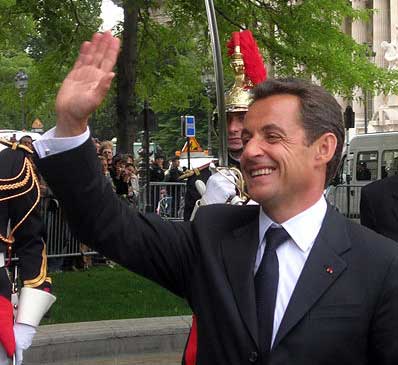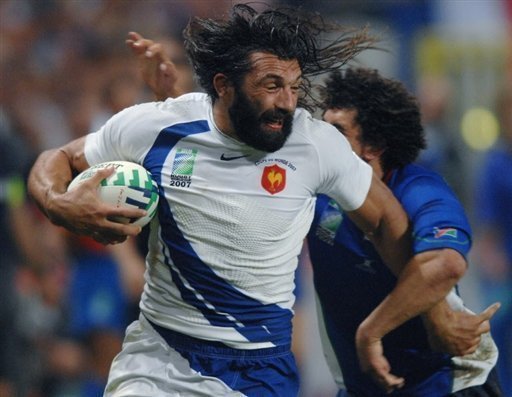Aidan Curran posted on December 31, 2007 05:48
Who was the first international leader seen by new French president Nicolas Sarkozy following his inauguration in June?
Chancellor Merkel? Nein! President Bush? Nope! Prime Minister Blair or Brown? Sorry, old chap!
The answer? CLUAS founder and editor Eoghan O’Neill.
 This is absolutely true: after the inauguration ceremony at the Elysée Palace, Sarko’s cavalcade was driving up the Champs-Elysées. Just before reaching the Arc de Triomphe for a wreath-laying ceremony, the pint-sized president (right) suddenly hopped out of his state car and rushed over to the crowds lining the grand old boulevard – straight to where the CLUAS gaffer (on a flying visit to the French capital) happened to be standing. One international statesman had recognised another, a fellow, a peer.
This is absolutely true: after the inauguration ceremony at the Elysée Palace, Sarko’s cavalcade was driving up the Champs-Elysées. Just before reaching the Arc de Triomphe for a wreath-laying ceremony, the pint-sized president (right) suddenly hopped out of his state car and rushed over to the crowds lining the grand old boulevard – straight to where the CLUAS gaffer (on a flying visit to the French capital) happened to be standing. One international statesman had recognised another, a fellow, a peer.
We’re not sure what advice, if any, our leader gave France’s; suffice it to say that not long afterwards Sarkozy was picking fights with the transport unions, physically confronting US paparazzi and throwing over his wife for a younger model/singer who had got a positive review on CLUAS (and she plans to release a new album of ‘love songs’ in 2008; the mind boggles).
Your Paris correspondent, not privileged to be in attendance at this Franco-Irish summit meeting, carried on through 2007 sketching the Venn diagram where ‘Irish music’ overlaps with ‘French music’. And such was the high level of activity there that our leisurely monthly column had to become a busy blog in order to cope. The Latin Quarter of CLUAS turned into something of a cultural meeting-point where green mixed with blue, pints were shared and croissants were broken in brotherhood.
These solid Franco-Irish relations took a battering (from the Irish point of view at least) on the rugby field. Vincent Clerc’s late try stole victory for les bleus at the historic first foreign game in Croke Park, and an even later try by Elvis Vermuelen against Scotland – on Saint Patrick’s Day! – won France the Six Nations at the expense of Ireland. The less said about Ireland’s disastrous World Cup, the better.
 If it’s any consolation, the home team also considered the Coupe du Monde de Rugby a failure. As they have done in nearly every tournament, le quinze de France played their final too early – their epic Cardiff quarter-final win over the All-Blacks was their psychological peak and England did enough to edge out the hosts in the semi-final.
If it’s any consolation, the home team also considered the Coupe du Monde de Rugby a failure. As they have done in nearly every tournament, le quinze de France played their final too early – their epic Cardiff quarter-final win over the All-Blacks was their psychological peak and England did enough to edge out the hosts in the semi-final.
And the French public didn’t really buy into the efforts to make a cult hero out of the caveman-esque Sebastien Chabal (left).
The only major Irish sporting success in France this year came in October, when the Aidan O’Brien-trained Dylan Thomas won the Prix de l’Arc de Triomphe, the country’s most prestigious horse race – and even then it looked as if officious French stewards would deny the Irish their win. (Oh, and your blogger NAILED the Paris Marathon.)
Our musicians fared much better on French soil. A plethora of Irish acts played in Paris during 2007: the French capital is now firmly established on the itinerary of any Irish band with ambitions of international success. In fact, we know of a Paris-based Irish agency, Oileán Promotions, which specialises in bringing acts over from Éire to play in France. And another Paris-based Irishman, Perry Blake, consolidated his French and international success with his seventh studio album, ‘Canyon Songs’.
This year there were Paris appearances by Duke Special, Nina Hynes, Simple Kid, The Immediate, The Thrills, The Frank And Walters, Sinead O’Connor, Roisin Murphy, The Answer and Neosupervital, amongst others. Outside the capital, Snow Patrol and The Divine Comedy played in provincial summer festivals.
In particular, Simple Kid and Duke Special gave remarkable Paris performances. Nina Hynes’ two concerts here suffered the misfortune of technical problems for the first gig and a transport strike for the second, yet the princess of Irish astral-pop put on two highly entertaining shows. The Immediate’s springtime shows in Paris proved to be among their last live appearances before the band broke up soon thereafter – snatching defeat from the jaws of victory, as the band’s French distributor had just blitzed the record shops and music press of Paris.
Plenty of French acts made the journey in the opposite direction and played to Irish audiences, most notably Justice (three times), Daft Punk, Manu Chao, The Teenagers, Nouvelle Vague (twice), Cassius, Emily Loizeau and Les Rita Mitsouko.
And Dublin now has something of a French scene; in 2007 we featured popular club nights such as French Friday and La Nuit Blanche, as well as Dublin-based French rocker Lauren Guillery. Irish acts are getting in on all this Frenchness too – the video for 'Love Like Nicotine' by Dark Room Notes recreated the famous dance scene from Jean-Luc Godard’s 'Bande À Parte', while Snow Patrol took a high-speed drive around a deserted early-morning Paris in their video for 'Open Your Eyes'.
Well, it looks like your blogger will be staying in Paris for a long time. Life here suits us. We hope our Gallic friends in Dublin and Ireland feel as happy in their home-from-home as we do in the French capital. Here’s the aforementioned video for 'Love Like Nicotine' (quite topical from a Paris context) by Dark Room Notes; see you in deux mille huit.
More ...
[Read more...]